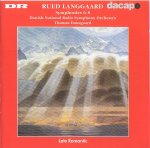Thomas Dausgaard’s reading of Rued Langgaard’s Symphony No. 6 “Det Himmelrivende” (The Heaven-rending) with the Danish National Radio Symphony brings to four the number of times the work has been recorded (three by this same orchestra). Neeme Järvi’s excellent account with the DNRSO on Chandos, coupled with Langgaard’s Fourth Symphony, is far superior to the Danacord version from the mid-1990s by the Rubinstein Philharmonic Orchestra and Ilya Stupel. Both Dausgaard and Järvi deliver vivid, cogent versions of No. 6, a work in the basic mold of Nielsen’s “Inextinguishable”, but far shorter. Orchestral playing for both conductors is very good indeed. Järvi favors faster speeds, and as so often with this conductor, the results are powerfully drawn and urgent. That often means Järvi isn’t so effective in giving the five through-composed variation sections distinct individuality (Variations II and III, Fuga, and Toccata sound rushed and headlong), something in which Dausgaard’s reading excels–but Stupel’s can be completely overlooked for its shabby playing and weak direction.
Dausgaard’s recording of Symphony No. 7 claims to be a world first, but that’s true only in that it’s the first recording of the piece in its 1926 revision, which differs little from the Danacord performance under Stupel; but again, Dausgaard’s is much better played. Langgaard’s Symphony No. 8 “Minder ved Amalienborg” is a ceremonial, heraldic work, much the most publicly accessible music on this disc, and Dausgaard plays it for all it’s worth, securing pomp and nobility in the outer sections in which the brass playing is notably sonorous. In all, these are useful performances that supercede Stupel’s in Symphonies 7 and 8, but Järvi is unquestionably more exciting in his fiery reading of No. 6, which also receives superior engineering from Chandos.
































